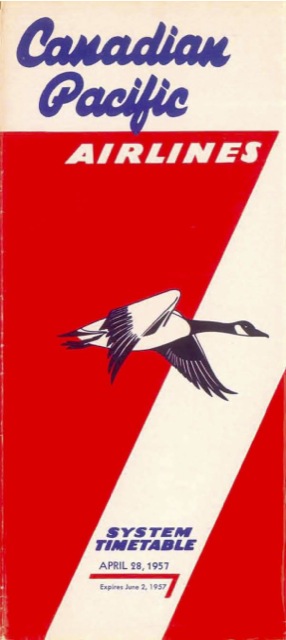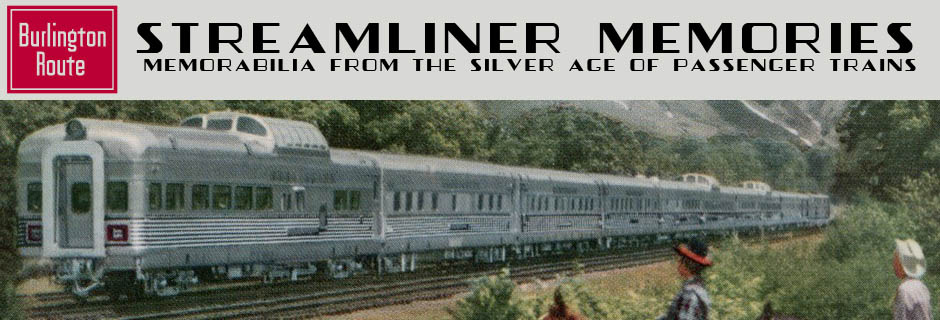During the 1950s and 1960s, the Canadian Pacific liked to call itself “the world’s most complete travel system” as it had trains, ships, trucks, and planes. One side of this brochure focuses on the trains, with Chesley Bonestell’s painting of the Canadian and large floor plans of each car on that train. But the map itself shows ocean liner routes to Europe and airplane routes to Asia and South America. In 1957, when this map was published, Canadian Pacific flew international routes with DC-4s that stopped in Hawai’i and Fiji on their way down under, Tokyo on the way to Hong Kong, and Mexico City on the way to Lima and Buenos Aires.
 Click image to download a 14-MB PDF of this map. Click here if you prefer the non-ocr version.
Click image to download a 14-MB PDF of this map. Click here if you prefer the non-ocr version.
Canadian Pacific Airlines is a sad story of private enterprise quashed by government regulation and favoritism towards the government-owned airline, Trans-Canada Air, which changed its name to Air Canada in 1965. When Canadian Pacific started to buy small “bush” airlines serving northern Canada, the Canadian government tried to discourage it. When CP started to expand to become a national and international carrier, the government allowed it to fly only the less-profitable routes, reserving the most profitable European destinations for its own airline.
 Click image to download a 1.8-MB PDF of this 1957 Canadian Pacific airline timetable. More CP Air timetables can be downloaded from the airline time table images site.
Click image to download a 1.8-MB PDF of this 1957 Canadian Pacific airline timetable. More CP Air timetables can be downloaded from the airline time table images site.
In the 1970s, trade between Asia and North America boomed, leading Air Canada to regret that the government had granted Asian air routes to CP. The government’s response was to finally agree to CP’s requests to have an “open skies” policy of allowing either carrier to go to any domestic or international destination.
Unfortunately, this proved to be Canadian Pacific’s undoing. While Air Canada could buy new planes to serve Asian routes with the full faith and credit of the Canadian government, CP Air had to go $1 billion in debt to buy new planes to serve European routes. In 1987, the competition with Air Canada combined with a downturn in the Asian economy forced Canadian Pacific to sell its airline to Pacific Western, a once-regional airline that had previously taken over CP Air’s bush routes.

Pacific Western paid CP $300 million plus absorbed $600 million in debt. It changed the name of the combined airlines to Canadian Airlines and used a modernized version of Canadian Pacific Air’s Canada goose logo as its trademark. The government privatized Air Canada in 1988, but Canada proved to be too small to support two national and international carriers. By 1999, Canadian Airlines was earning $3 billion in revenue, but losing $2 million a day. In 2000, it sold out to Air Canada for a mere $92 million. Canadian Pacific’s goose flew no more.

A slight correction to the aircraft on the timetable cover. That’s actually a Canadair DC-4M North Star, a similar but not identical aircraft to the Douglas DC-4. The North Star used Rolls Royce Merlin, a liquid cooled variant of the same engine the powered the Spitfire and P-51 Mustang. It had parts from the Dc-6, DC-4, and C-54, and it was pressurized, unlike the standard DC-4. It had a cruise speed about 50 mph higher than the DC-4, but the Merlins were much noisier than the Pratt & Whitney radials and fuel thirsty. It was still one of the better prop jobs for long distance routes but, by 1967, turboprops were already in use and jets like the Comet and Caravelle were also flying. The North Star, because of its rugged construction, lasted longer than most DC-4’s in passenger service, but its days were numbered by 1957.
CP still couldn’t maps right though. There’s a connecting rail line between Ludlow on the AT&SF and Crucero on the UP in the Mojave Desert shown on the map. The only rail line in that place was the Tonopah and Tidewater. That portion of the line was abandoned in 1933 due to flood damage, and the rest of the T&T was abandoned by 1942, a victim of low traffic and the WWII ban on gold mining. How that small portion of track showed up on a 1957 CP map is beyond me.